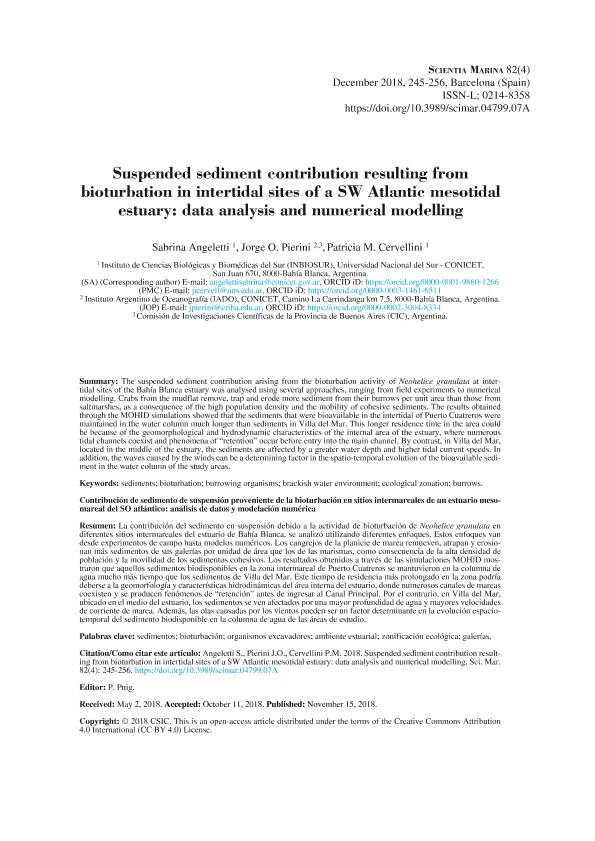Mostrar el registro sencillo del ítem
dc.contributor.author
Angeletti, Sabrina

dc.contributor.author
Pierini, Jorge Omar

dc.contributor.author
Cervellini, Patricia Marta

dc.date.available
2024-03-21T12:57:50Z
dc.date.issued
2018-11-15
dc.identifier.citation
Angeletti, Sabrina; Pierini, Jorge Omar; Cervellini, Patricia Marta; Suspension sediment contribution from bioturbation in intertidal sites of SW Atlantic mesotidal estuary: data analysis and numerical modelling; Instituto de Ciencias del Mar Barcelona; Scientia Marina; 82; 4; 15-11-2018; 245-256
dc.identifier.issn
0214-8358
dc.identifier.uri
http://hdl.handle.net/11336/231147
dc.description.abstract
The suspended sediment contribution arising from the bioturbation activity of Neohelice granulata at intertidal sites of the Bahía Blanca estuary was analysed using several approaches, ranging from field experiments to numerical modelling. Crabs from the mudflat remove, trap and erode more sediment from their burrows per unit area than those from saltmarshes, as a consequence of the high population density and the mobility of cohesive sediments. The results obtained through the MOHID simulations showed that the sediments that were bioavailable in the intertidal of Puerto Cuatreros were maintained in the water column much longer than sediments in Villa del Mar. This longer residence time in the area could be because of the geomorphological and hydrodynamic characteristics of the internal area of the estuary, where numerous tidal channels coexist and phenomena of “retention” occur before entry into the main channel. By contrast, in Villa del Mar, located in the middle of the estuary, the sediments are affected by a greater water depth and higher tidal current speeds. In addition, the waves caused by the winds can be a determining factor in the spatio-temporal evolution of the bioavailable sediment in the water column of the study areas.
dc.description.abstract
La contribución del sedimento en suspensión debido a la actividad de bioturbación de Neohelice granulata en diferentes sitios intermareales del estuario de Bahía Blanca, se analizó utilizando diferentes enfoques. Estos enfoques van desde experimentos de campo hasta modelos numéricos. Los cangrejos de la planicie de marea remueven, atrapan y erosionan más sedimentos de sus galerías por unidad de área que los de las marismas, como consecuencia de la alta densidad de población y la movilidad de los sedimentos cohesivos. Los resultados obtenidos a través de las simulaciones MOHID mostraron que aquellos sedimentos biodisponibles en la zona intermareal de Puerto Cuatreros se mantuvieron en la columna de agua mucho más tiempo que los sedimentos de Villa del Mar. Este tiempo de residencia más prolongado en la zona podría deberse a la geomorfología y características hidrodinámicas del área interna del estuario, donde numerosos canales de mareas coexisten y se producen fenómenos de “retención” antes de ingresar al Canal Principal. Por el contrario, en Villa del Mar, ubicado en el medio del estuario, los sedimentos se ven afectados por una mayor profundidad de agua y mayores velocidades de corriente de marea. Además, las olas causadas por los vientos pueden ser un factor determinante en la evolución espacio temporal del sedimento biodisponible en la columna de agua de las áreas de estudio.
dc.format
application/pdf
dc.language.iso
eng
dc.publisher
Instituto de Ciencias del Mar Barcelona

dc.rights
info:eu-repo/semantics/openAccess
dc.rights.uri
https://creativecommons.org/licenses/by/2.5/ar/
dc.subject
Bioturbation
dc.subject
Burrowing organisms
dc.subject
Brackish water environment
dc.subject
Ecological zonation
dc.subject
Sediments
dc.subject
Burrows
dc.subject.classification
Oceanografía, Hidrología, Recursos Hídricos

dc.subject.classification
Ciencias de la Tierra y relacionadas con el Medio Ambiente

dc.subject.classification
CIENCIAS NATURALES Y EXACTAS

dc.title
Suspension sediment contribution from bioturbation in intertidal sites of SW Atlantic mesotidal estuary: data analysis and numerical modelling
dc.title
Contribución de sedimento de suspensión proveniente de la bioturbación en sitios intermareales de un estuario mesomareal del SO atlántico: análisis de datos y modelación numérica
dc.type
info:eu-repo/semantics/article
dc.type
info:ar-repo/semantics/artículo
dc.type
info:eu-repo/semantics/publishedVersion
dc.date.updated
2019-10-24T18:18:56Z
dc.identifier.eissn
1886-8134
dc.journal.volume
82
dc.journal.number
4
dc.journal.pagination
245-256
dc.journal.pais
España

dc.journal.ciudad
Barcelona
dc.description.fil
Fil: Angeletti, Sabrina. Consejo Nacional de Investigaciones Científicas y Técnicas. Centro Científico Tecnológico Conicet - Bahía Blanca. Instituto de Ciencias Biológicas y Biomédicas del Sur. Universidad Nacional del Sur. Departamento de Biología, Bioquímica y Farmacia. Instituto de Ciencias Biológicas y Biomédicas del Sur; Argentina
dc.description.fil
Fil: Pierini, Jorge Omar. Consejo Nacional de Investigaciones Científicas y Técnicas. Centro Científico Tecnológico Conicet - Bahía Blanca. Instituto Argentino de Oceanografía. Universidad Nacional del Sur. Instituto Argentino de Oceanografía; Argentina. Provincia de Buenos Aires. Gobernación. Comisión de Investigaciones Científicas; Argentina
dc.description.fil
Fil: Cervellini, Patricia Marta. Consejo Nacional de Investigaciones Científicas y Técnicas. Centro Científico Tecnológico Conicet - Bahía Blanca. Instituto de Ciencias Biológicas y Biomédicas del Sur. Universidad Nacional del Sur. Departamento de Biología, Bioquímica y Farmacia. Instituto de Ciencias Biológicas y Biomédicas del Sur; Argentina
dc.journal.title
Scientia Marina

dc.relation.alternativeid
info:eu-repo/semantics/altIdentifier/url/http://scientiamarina.revistas.csic.es/index.php/scientiamarina/article/view/1783
dc.relation.alternativeid
info:eu-repo/semantics/altIdentifier/doi/http://dx.doi.org/10.3989/scimar.04799.07A
Archivos asociados
